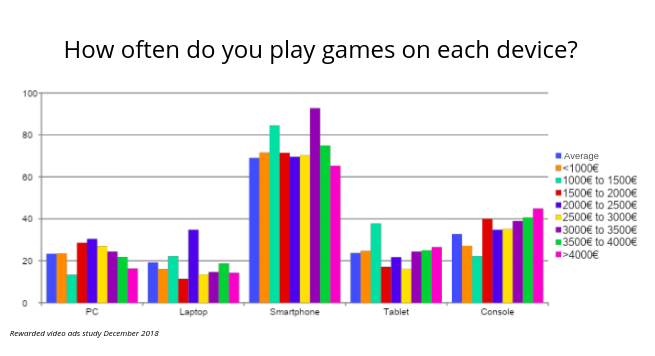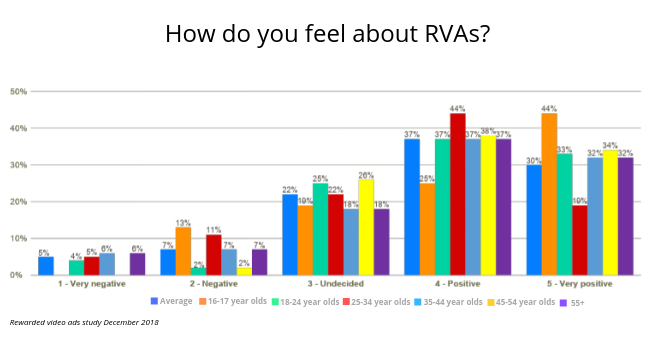Study shows RVAs lead to an overwhelmingly positive ad experience
The gaming industry has grown significantly over the past decade and there’s no sign of it slowing down, especially within the mobile space.
In 2018 Candy Crush made just over $1 billion in revenue, and Pokemon Go, yes the same Pokemon Go the world went crazy for three years ago, is on track to do the same. Niantic, the company behind Pokemon Go, will soon launch its next game set in the world of Harry Potter, which means it’s guaranteed to become a multi-billion dollar hit.
What are RVAs?
If you’ve ever played a mobile game, you’ll most likely have encountered an RVA. They often pop up when you’re out of lives or cash and offer you more in exchange for watching an ad.
The mobile gaming audience is as diverse as the range of games available, with all ages, genders, incomes and backgrounds represented. It a compelling environment for advertisers, so with this in mind we ran a study on advertising in online gaming environments with the Hamburg University of Applied Sciences (HAW), looking at gaming habits and the effectiveness of Rewarded Video Ad formats (RVAs).
How often do we play games?
Germany was chosen as an advanced western market, and the study looked at the gaming behaviour of just over 500 people from age 16 to 75 years old and collected their opinions on different in-game advertising formats.
The study found that 87% of the recipients played games, with most doing so daily to several times a week (73%), predominantly on smartphones.

How do you feel about RVAs?
Respondents were asked: ‘How do you feel about video advertising in a game app/browser game when it is associated with a reward?’ Only 12% of respondents felt negative or very negative towards RVAs, and a massive 67% of respondents expressed a positive response towards this ad format.
It’s really interesting to see such a positive response towards RVAs, indicating that giving the user a choice as to whether they watch the ad, and offering them a value exchange results in a positive experience for the user.
However, it’s not only the user that benefits, to be able to receive the reward the ad has to be watched the whole way through, resulting in higher completion rates for advertisers. A recent survey by OpenX found that 90% of marketers agreed that opt-in video generates stronger engagement metrics for ads compared with other formats.

Giving control back to the consumer
This trend of putting the user in control, and giving them a choice is one of the drivers behind future facing ad formats like shoppable and interactive video, where users navigate their way through ads.
Now that we know how well RVAs are received, the next stage of this research will be to find out whether they are effective. It’s interesting to note that although you need to watch an ad the whole way through to receive the reward, it’s optional as to whether you keep the sound on or not. This then begs the question, how effective is the ad without sound? The effectiveness of silent ads is a whole other discussion but it’s interesting to think about here, especially when you consider that sound on or off is not usually a metric that is reported on when reporting on how RVAs performed.
Other questions we’d like to find out the answers to are whether users actually pay attention when they chose to watch ads, or do they carry out other actions while it’s being played? And does the reward received by watching the ad, like extra lives, mean that the player carries on playing rather than clicking on the ad and being taken out of the game? The next stage of this research will be to look into the results of RTAs to find out how effective they are in driving brand recall and purchase intent.
Want to find out more about RVAs?
Check out our UnrulyX marketplace offering and get in touch to find out how we could help!
